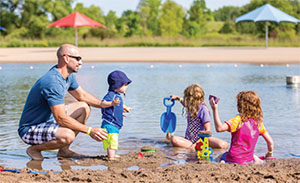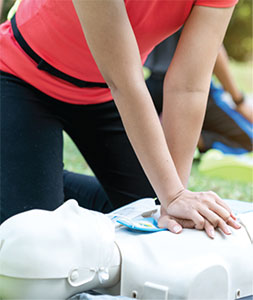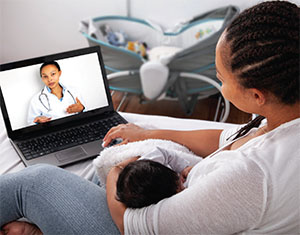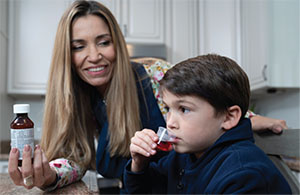Spring 2023
Building Trust and Respect
 For children and their caregivers, trust and respect are essential for a strong, healthy relationship. From the day a baby is born, we make them feel safe and secure when we give them what they need. Over time, this foundation of support helps a child develop positive self-esteem, self-confidence and resilience, which can all contribute to mental wellness. Here are some ideas to ensure that as your child matures, mutual trust and respect are at the center of your relationship.
For children and their caregivers, trust and respect are essential for a strong, healthy relationship. From the day a baby is born, we make them feel safe and secure when we give them what they need. Over time, this foundation of support helps a child develop positive self-esteem, self-confidence and resilience, which can all contribute to mental wellness. Here are some ideas to ensure that as your child matures, mutual trust and respect are at the center of your relationship.
Respond to their needs. When you consistently meet your child’s physical and emotional needs over time, they grow up knowing they can depend on you. This deep feeling of security means that, at any age, they’ll be able to come to you for help and advice.
Be steady and reliable. Be consistent with your words and actions and try to always keep your promises. If you take your child to school or pick them up after, be on time. If you’ve promised a special outing or said that you’ll attend their school event or game, you must follow through.
Set and enforce family rules. It’s a good thing to have rules that are fair, firm and logical. Reasonable, consistent rules help children feel safe and cared for, and understand what’s expected of them. And as kids learn to follow the rules, they earn more trust and respect from their caregivers — and thus more freedom.
Show that you understand and approve of them. Commit to fully understanding and embracing your child for exactly who they are. Show them that you approve of them and that you respect their feelings and opinions. Develop an interest in whatever interests them.
Be an open, active listener. Whenever possible, give your child your full attention when they’re talking to you. Nod, look them in the eyes and react with your facial expressions. If they have a problem, be empathetic and help them work out their own solution, rather than solving it for them. Listen more than you talk.
Entrust them with responsibilities. Allowing your child to do chores — and eventually master these tasks — boosts their confidence and resourcefulness. It also shows them that you trust them. When your child is ready, encourage them to take age-appropriate paying jobs. These experiences will develop their self-reliance and independence.
Love, affection, acceptance, safety and security are all more powerfully felt when they are rooted in trust and respect!
What Is Mindful Eating?
 Have you ever had a favorite snack food in front of you while watching TV or a video, then looked down and been surprised to see you’d eaten it all? It’s not unusual! This is known as mindless eating, and it’s best to avoid doing it. Instead, we can practice what’s known as mindful eating.
Have you ever had a favorite snack food in front of you while watching TV or a video, then looked down and been surprised to see you’d eaten it all? It’s not unusual! This is known as mindless eating, and it’s best to avoid doing it. Instead, we can practice what’s known as mindful eating.
Mindful eating means slowing down and focusing on the food we are having, and appreciating the way it looks, smells and tastes. It includes choosing nourishing foods and training ourselves to pay close attention to when our bodies are truly hungry and when we’re full. This can make
eating more enjoyable and leave us feeling more satisfied and fulfilled. When we commit to mindful eating it doesn’t mean that we eat perfectly all the time — but it’s a powerful tool for living a healthier life!
Busting a Drowning Myth and More on Water Safety
 For children of all ages, drowning is a leading cause of unintentional death. One of the biggest myths about drowning is that it’s loud, with lots of splashing and yelling. This is a dangerous false belief. It causes many parents and caregivers to wrongly believe they can do other things when a child is in or near water. The truth is that drowning is often quick and silent, with a child simply slipping under the surface, not seen or heard by anyone.
For children of all ages, drowning is a leading cause of unintentional death. One of the biggest myths about drowning is that it’s loud, with lots of splashing and yelling. This is a dangerous false belief. It causes many parents and caregivers to wrongly believe they can do other things when a child is in or near water. The truth is that drowning is often quick and silent, with a child simply slipping under the surface, not seen or heard by anyone.
Constant supervision and following strict water-safety rules can mean the difference between life and death.
Supervise children in the water, giving them your undivided attention. Stay within arm’s reach of young children and inexperienced swimmers. Constantly watch all children swimming or playing in the water, even if they know how to swim, and even when lifeguards are present.
Supervise children near the water, watching them closely even when waterplay and swimming are not part of your plan.
Designate an official ‘water watcher’ when children are in or even near the water. This should be a responsible adult.
Stay vigilant and focused when supervising. Never use alcohol or other drugs during water-related activities. And don’t try to multitask while supervising or water watching — this includes looking at your smartphone.
Enforce rules about wearing life jackets, ensuring they are the right size and that they are properly adjusted for a safe, snug fit. This goes for adults, too.
Learn more about drowning prevention.
CPR Saves Lives
 CPR, or cardiopulmonary resuscitation, is an emergency procedure that can help save a person’s life when their heart stops beating. CPR uses chest compressions to help keep a person’s blood flowing throughout their body, including to their brain and lungs. When CPR is started quickly and performed well, it can be lifesaving. It’s an important skill to know, and it doesn’t take long to learn. Here are some ways to find a CPR class near you:
CPR, or cardiopulmonary resuscitation, is an emergency procedure that can help save a person’s life when their heart stops beating. CPR uses chest compressions to help keep a person’s blood flowing throughout their body, including to their brain and lungs. When CPR is started quickly and performed well, it can be lifesaving. It’s an important skill to know, and it doesn’t take long to learn. Here are some ways to find a CPR class near you:
- Visit the American Heart Association.
- Visit the American Red Cross.
- Check out Seattle Children’s CPR and First Aid for Babysitters course.
Until you can take an in-person class, you can learn hands-only CPR by watching a short American Heart Association video. This method is for use on teens and adults, and it can buy time until professional help arrives.
New Virtual Urgent Care from Seattle Children’s
 Seattle Children’s now offers telemedicine for some urgent care appointments. Patients can see, hear and talk with a Seattle Children’s urgent care provider through a computer, phone or other digital device with an internet connection.
Seattle Children’s now offers telemedicine for some urgent care appointments. Patients can see, hear and talk with a Seattle Children’s urgent care provider through a computer, phone or other digital device with an internet connection.
For these online appointments, patients must be present in Washington state during the time of their visit. They must also be accompanied by a legal guardian. Seattle Children’s Virtual Urgent Care is offered 7 days a week, including holidays.
Hours are Monday through Friday from 1 to 9 p.m., and Saturday and Sunday from 11 a.m. to 7 p.m. Learn which symptoms and conditions can be evaluated through a virtual urgent care appointment and get more details about this new service.
Medicine Dosing and Safety Reminders
 To be sure that medicines are both safe and effective, it’s crucial to follow dosing and safety rules.
To be sure that medicines are both safe and effective, it’s crucial to follow dosing and safety rules.
- Always read the instructions on the medicine label and follow them carefully, including those relating to age and weight.
- For liquid medicines, use the measuring device that came with the medicine. Never use a household spoon to measure medicine.
- Record when you’ve given a dose and how much you give. This serves as a reminder to yourself and ensures a safe ‘hand-off’ to other caregivers.
- Cold medicines often contain more than one type of medication. Always check the list of active ingredients to ensure you don’t give medicine for fever or pain if you already gave a cold medicine that contains a fever or pain medicine. When possible, it’s best to give just one medicine at a time.
- Always ask your child’s doctor or other healthcare provider if you have any questions.
- Teach your child to take medicine only when it’s given to them by a trusted adult.
- Never call medicine ‘candy’ to entice a child to take it. This is confusing and may cause a child to search for it and sneak it.
- Keep medicines in their original containers with child-safety caps, but don’t trust these caps to keep a child from opening them.
- Keep all medicines out of sight, up high and out of reach of children. A locked cabinet is safest.
- Be prepared for poisoning emergencies by saving the National Poison Center help line in all your phones: 1-800-222-1222.
- Call the National Poison Center right away if you think your child might have gotten into a medicine or vitamin.
- Properly dispose of medicine when it’s expired or you no longer need it. Learn how and where to do this.
And of course, be sure that all those who care for your child — including babysitters and grandparents — follow these safety guidelines.
See Safe Medicine Storage and Disposal to Prevent Misuse to learn more on that topic.


